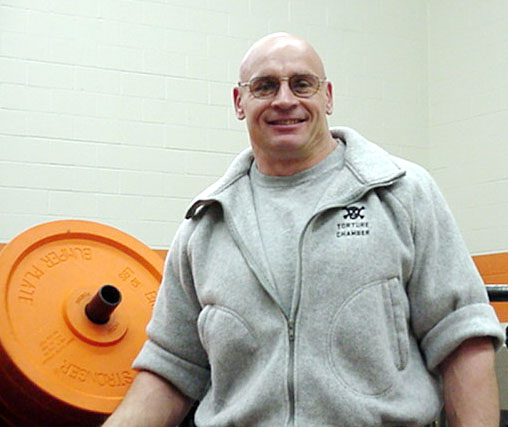
A look back at a 2001 interview with the “muscle man.”
Steve Studer may no longer be with us in person (he passed away in February 2004), but his legacy as a sports fixture at WHS and the Massillon community will not be forgotten. Very much a family man, he was also highly devoted to students of the school, motivating them to succeed in life through weight training and inspiration. What made the program a success was his high energy level and passion to succeed, attributes that will not soon be replaced. In 2001 I had the pleasure of talking with Coach Stu about the Massillon High School weight program. Here is that interview.
A 2-year varsity football player for Massillon, Studer was the starting center on the 1970 state championship team that also featured Tiger greats Dennis Franklin, Steve Luke, Mike Mauger, Larry Harper, Tim Ridgley, Willie Spencer and Tom Hannon. He also played in 1971, before becoming the starting center for the Bowling Green Falcons. After college he had a couple tryouts with professional football teams, but eventually landed a position as strength and conditioning coach/phys-ed teacher at Massillon High School.
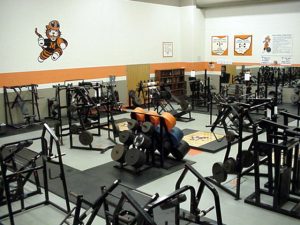 “Our weight room is 55’ by 70’,” said Studer. “It’s the same size as the weight room we had at the old high school. When we built the new high school we patterned it after the old one. It pretty much consists of free weights.
“Our weight room is 55’ by 70’,” said Studer. “It’s the same size as the weight room we had at the old high school. When we built the new high school we patterned it after the old one. It pretty much consists of free weights.
“Our core lifts are the squat, the clean, the bench press, and the dead lift. The machines that we have in the weight room are pretty much hammer-strength machines and it’s all top of the line equipment. It’s the same equipment that they use at Michigan, Notre Dame, and a lot of the NFL teams.
“We really compare the weight room to a lot of Division 1 colleges. There’s going to be your Tennessees, your Nebraskas, and your Michigan States where they have a better facility than this. I would compare this to any MAC school.
“We get a lot done in here and every year I work with a good 200 kids that pass through this weight room, at least four days a week. We’re pretty proud of it and right now as you take the pictures it looks very clean and we keep it that way because we take good care of it.
“But, believe me, we use it, and in the evenings it’s a pretty gross picture in here as far as the way it smells and when I’m carrying buckets out of here. It reminds you of a Rocky movie when you see the kids in here training.”
If I recall, you won the Mr. Ohio contest a couple of times.
When I was in college in the 70s is really when weight training took off and it got started in Nebraska and everybody was trying to emulate as much as possible what they were doing. And I know that’s what we did at Bowling Green.
 After college football and after trying out with the Chicago Bears and trying out with the USFL, I wasn’t ready to stop my competitive juices. I got into powerlifting for about five years and competed at that level and then got into some body buildings and physique for about five years and then it was after that I started coaching.
After college football and after trying out with the Chicago Bears and trying out with the USFL, I wasn’t ready to stop my competitive juices. I got into powerlifting for about five years and competed at that level and then got into some body buildings and physique for about five years and then it was after that I started coaching.
I had my own private gym where I had about 10-12 kids here from Massillon: the Spielman brothers, Johnny Miller, Jared Vance, Darrell Strickland. A really nice group of guys. We trained in my own private place. I didn’t make a penny doing it. I did it for the love of doing it. And that’s kind of when John Moronto had taken me in here.
Tell me a little bit about your background as coach of the strength program.
Actually I started here underJohn Moronto (1985-87 football coach) at the old high school. As I started it was an after school thing. I actually worked for my father as a sign painter. At 3:00 when the school let out I would go to the old high school and the weight room down there and work out the team. I did that four days per week.
Then when Lee Owens (1988-91 football coach) came here and we actually started this as a class. I was hired here at the high school full time and left my father at the sign shop to come up here. It’s really my first love. I love being here because I love working with the kids and it’s not just football here with me.
I train every sport. And a lot of our football players do play other sports. It adds up to about 200 kids a year that I train. I enjoy it because it’s my alma mater and it’s something I’ve always wanted to do. I don’t think I’d like to be anywhere else. I’m happy. I enjoy coming to work and when you look forward to coming to work each morning it’s pretty good.
Each sport I’m sure has a different weight training program. How do you address that?
There are some things that we do. For instance, there are some things that we do differently for a baseball player than you would for a wrestler. But, pretty much the lifts that we do in this room are specifically to make kids stronger on the basketball court, like make them jump higher or enable them to shoot for a takedown in wrestling. And you come off the ball as an offensive lineman or make a big hit as a linebacker. And all the things we do are predicated to make kids jump higher, ran faster, be more explosive.
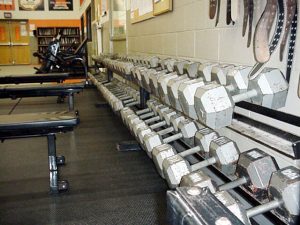 And a lot of things we do are things that are on our feet, like squatting and cleaning and dead lifting and lunging. Those things develop the center of the body, the hips, thighs, and lower back and we do a lot of work on our stomachs. And those are all the areas that make you faster and make you more athletic.
And a lot of things we do are things that are on our feet, like squatting and cleaning and dead lifting and lunging. Those things develop the center of the body, the hips, thighs, and lower back and we do a lot of work on our stomachs. And those are all the areas that make you faster and make you more athletic.
The days of having a lot of guys out there on the football field with big bellies are gone. It’s not what we’re looking for now. We want the kids to be able to move. Speed is the name of the game, but you have to have the strength in there, too. And you have to do things that are going to help prevent injury. You want to work the joints, especially the whole knee capsule. If a kid does get hurt and he would have to have surgery, he comes back from that surgery because he’s built that area up. Maybe, a lot of times, you’ll see kids that get hurt and because they’ve built those areas up they don’t need the surgery. And that’s what it’s all about there.
Describe the kids’ mental approaches to lifting?
We like to see that they all have the same approach and that approach would be to come in here and improve every time you walk in the place. That’s the attitude. And it’s one of the reasons why right now in the wintertime we try to get every football player.
Right now we have every football player not involved in a winter sport lifting together in this room as a team. The leadership kind of spreads throughout it because it’s a tough thing to do, and we want it to be tough, but we want that team unity to be formed out of it. That’s really the thing we are trying to accomplish right now.
Do you get many girls involved in the program?
We have two girls’ classes that I don’t teach. Barb Heigl is the phys-ed teacher who runs the two girls classes. As far as the classes go, I have six classes throughout the day with 25 kids in each class and then I’ve got the group that works out here after school. It depends on what time of the year and what phase we’re in, but this room gets used all year round. I take two weeks off in the summer and I’m still here in the summer keeping the place open for the guys.
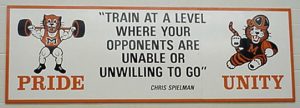 That’s kind of my little pet peeve. Because, if you would have seen it last night when I was carrying the puke buckets out of here and the floor was full of sweat. Then what happens is I come in here at 5:00 am and I take an hour and a half or two hours scrubbing this place down. I’ve been doing it for ten years since this building was built. I don’t let the janitors in the room. I take care of it myself because I’m proud of it and the way I look at it is this is my classroom. I think when people come around and they look at the school and they walk in the weight room and see that it’s well kept, it’s just a pride thing.
That’s kind of my little pet peeve. Because, if you would have seen it last night when I was carrying the puke buckets out of here and the floor was full of sweat. Then what happens is I come in here at 5:00 am and I take an hour and a half or two hours scrubbing this place down. I’ve been doing it for ten years since this building was built. I don’t let the janitors in the room. I take care of it myself because I’m proud of it and the way I look at it is this is my classroom. I think when people come around and they look at the school and they walk in the weight room and see that it’s well kept, it’s just a pride thing.
The Lift-a-thon is coming up this Saturday at 10:00 am, so tell me a little about that event.
We always raise money every year and the kids vote on what they want to buy new and we always get a new piece of equipment or maybe some new rubber to put down on the floor or some more bars, whatever we need. It’s taken us 15 years to build this place up to what you see right now and I’m a big stickler of taking care of it.
We’ve raised all this money, not one tax dollar. Down to the lightest plate in here, it’s all raised through lift-a-thons since I’ve been here through John Moronto. Some people might think I’m crazy. ‘There’s Stu at 5:00 in the morning sweeping and mopping the weight room. And he takes better care of the weight room than he does his own house.’ I admit it, but that’s just the way it is.
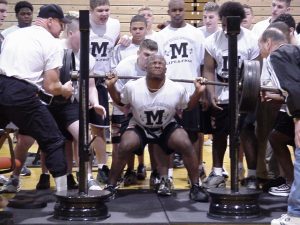 The Lift-a-thon is how we end up the winter conditioning. Our off-season program this year has gone from January 4 to March 3. It’s a very intense time of the year. Just because we have the Lift-a-thon to close it up doesn’t mean we stop. It just means we go on to track season, maybe some different style of lifting during that time. The Lift-a-thon is a big test week. We’ll test on things during the week, especially speed. We’ll test on the 20, the 40, the pro-agility, the 60-yard shuttle; we’ll test on those things. And we’ll test on the clean and the squat at the Lift-a-thon. I kind of like to make it like a weight lifting meet, where I hand out medals, weigh them in. They all come in at different weight classes.
The Lift-a-thon is how we end up the winter conditioning. Our off-season program this year has gone from January 4 to March 3. It’s a very intense time of the year. Just because we have the Lift-a-thon to close it up doesn’t mean we stop. It just means we go on to track season, maybe some different style of lifting during that time. The Lift-a-thon is a big test week. We’ll test on things during the week, especially speed. We’ll test on the 20, the 40, the pro-agility, the 60-yard shuttle; we’ll test on those things. And we’ll test on the clean and the squat at the Lift-a-thon. I kind of like to make it like a weight lifting meet, where I hand out medals, weigh them in. They all come in at different weight classes.
We have a record board up here on the wall and the kids try and break records. We started the record board in ’91, so the record board’s now ten years old. And it’s harder and harder to get up there on that board every year. We still have a couple ‘91s up there. But, they shoot for those kinds of goals at the Lift-a-thon. It gets intense and they all get to go out and raise a little money and at the end of it we add all the money up and figure out what we want to do for the weight room.
Thanks, Coach Stu.
